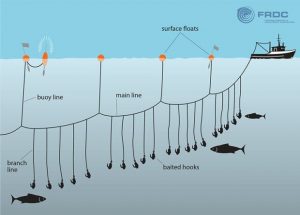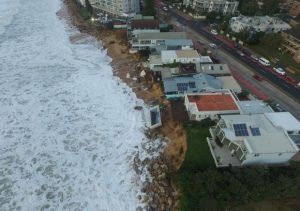Australia will trump even Donald Trump and become the first nation to cut protections of its ocean estate if it implements plans, released by the Federal Government, to expose vulnerable areas of the marine environment to industrial fishing exploitation.
An election promise to be science-based has been ignored in changes proposed to the national network of marine sanctuaries, the Save Our Marine Life alliance of 25 national and state environment groups said.
Federal Environment Minister Josh Frydenberg has released maps detailing planned cutbacks to protection of coral reefs and key feeding and breeding areas around Australia, but particularly in the Coral Sea.
Tourism jobs will also be placed at risk, particularly in the valuable dive and whale watching sectors, if Australia’s reputation as a destination for unspoilt nature experiences is damaged, according to the Australian Marine Conservation Society.
“Australia will trump even Donald Trump if it implements these cut backs,” AMCS director Darren Kindleysides said. “No other nation has chosen to go backwards in the protection of its ocean estate. In the US, the Trump administration has launched a review, but Australia is now at the end of its review, ordered by former Prime Minister Tony Abbott in 2013.
“All Australians will be justifiably distressed to know that science evidence supporting an increase in protections for marine life has been thrown out the window,” Mr Kindleysides said.
More than 3.5 years after the Abbott Review of national marine sanctuaries was launched, commercial fishing has emerged as the biggest beneficiary. Large areas of Queensland’s Coral Sea, as well as sanctuary protections off the coast from Western Australia, the Northern Territory and NSW could be scrapped to make way for an expansion of long-line fishing and seafloor trawling.

“The threat to jobs, local businesses and to the survival of unique marine life could be avoided if the government instead chose to create an evidence-based balance for Australia’s oceans,” Michelle Grady, oceans director from the Pew Charitable Trusts said.
“The government-appointed review panel reinforced the importance of marine sanctuaries and Australia’s leading marine scientists have informed the Environment Minister of the threat to the productivity of our oceans if sanctuaries are removed,” she said.
“Fishing is an important part of Australian life and economic activity, but so is our tourism sector and the opportunity for all Australians to experience nature unspoilt by industry. The success of our ‘blue economy’ depends on securing a healthy marine environment, not in undermining it.”
Senate fight on the horizon
The Labor Party is proud of the protection plans it established and is promising a fight.
In 2012, Labor released what it says was the world’s largest network of marine national parks and protected areas. The network was said to be based on the latest science and extensive community consultation.
Midwater trawling is to be reintroduced and it will be now be possible for long-lining to start at the southern tip of the Coral Sea reserve and continue all the way to the northern boundary.
“Labor will not stand by and see our precious oceans be attacked. Labor will fight to prevent any backward steps on ocean protection.”
The Greens will join
The Turnbull Government’s attempts to gut ocean protections will face a fight in the Senate and at the next election, the party declared.
Senator Peter Whish-Wilson, Greens spokesperson for Healthy Oceans, said: “Environment Minister Josh Frydenberg has released draft maps showing protections for coral reefs and critical ecosystems will be gutted around Australia.
“If the Turnbull Government wants to pick a fight with Australians who love our oceans then they will get one as any attempt to gut ocean protections will face a disallowance in the Senate.
“This is the worse possible time to be scaling back environmental protections, it will make us into another international embarrassment just as we have witnessed with LNP climate vandalism.”
The Reef will suffer
The Queensland Minister for the Great Barrier Reef Steven Miles slammed the Federal Government’s proposal to decrease the Coral Sea marine park protected area by 76 per cent.
“This latest Federal Government Marine Reserves review proposes to cut protections for our marine life and their habitat.
“This is another example of the Turnbull Government walking away from the Great Barrier Reef.
“Marine Protection is not only good for the environment it is good for the Queensland tourism industry and the 64,000 jobs in supports.
Will the ocean fight back?
Shifting storms will bring extreme waves, seaside damage to once placid areas, a recent study found, concluding that sea level rise is no longer the only impact climate change will bring to the world’s coastlines.
What is claimed to be the world’s most extensive study of a major stormfront striking the coast has revealed a previously unrecognised danger from climate change: as storm patterns fluctuate, waterfront areas once thought safe are likely to be hammered and damaged as never before.

The study, led by engineers at University of New South Wales in Sydney, was published in the latest issue of the journal Nature Scientific Reports.
“If you have waterfront property or infrastructure that has previously been sheltered from the impacts of extreme waves, this is worrying news” said Mitchell Harley, lead author and a senior research associate at UNSW’s Water Research Laboratory (WRL).
“What this study confirms, is that simply by changing direction, storms can be many times more devastating. And that’s what we’re facing in many locations as the climate continues to change.”
Ian Turner, director of WRL and a co-author, said sea level rise was no longer the only factor at play when preparing for the impact of climate change on waterfront areas. “Shifts in storm patterns and wave direction will also have major consequences, because they distort and amplify the natural variability of coastal patterns.”
The study relied on data collected during the June 2016 ‘superstorm’ that battered eastern Australia, one of the fiercest in decades: it inundated towns, smashed buildings, swept away cars and infrastructure and triggered hundreds of evacuations across a 3,000 km swathe from Queensland in the north all the way to Tasmania in the south. Three people died and there were more than 80 rescues from stranded cars.
Comment below to have your say on this story.
If you have a news story or tip-off, get in touch at editorial@governmentnews.com.au.
Sign up to the Government News newsletter
Most read
Scathing report finds little has changed at PwC
Qld council welcomes progress on massive battery system
Inquiry to consider how federal govt can address councils’ sustainability issues
‘Local’ procurement turns out not to be so local, committee hears
Another report finds local government falling down on cyber security
